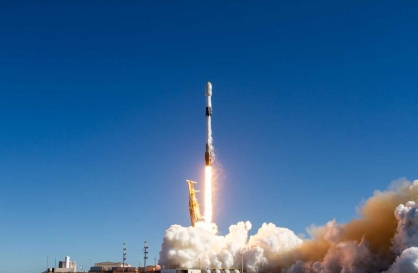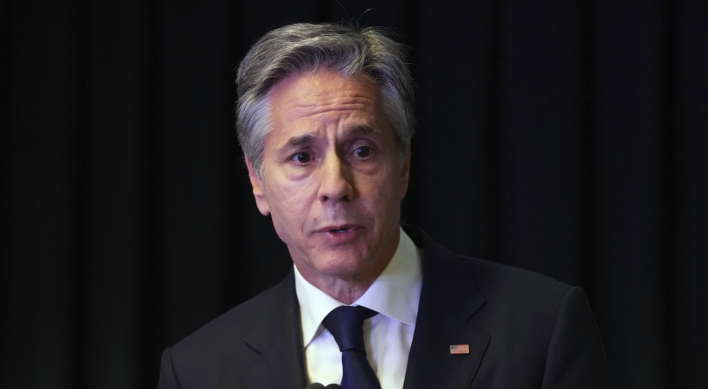S&P downgrades Fannie, Freddie, other agencies linked to long-term U.S. debt
NEW YORK (AP) — The U.S. stock market joined a sell-off around the world Monday in the first trading since Standard & Poor's downgraded American debt and gave investors another reason to be anxious.

Monday was the first chance for global investors to respond to S&P's announcement late Friday that it was reducing its credit rating for long-term U.S. government debt by one notch, from AAA, the highest rating, to AA+.
The move wasn't a total surprise but came when investors were already feeling nervous about a weak U.S. economy, European debt problems and Japan's recovery from its March earthquake.
Fresh memories of the financial crisis three years ago are also driving investors away from risky investments and into what's considered safer.
"Fear of a repeat of 2008 is what's really driving investments," said Gary Schlossberg, senior economist with Wells Capital Management.
In other trading on Wall Street, the S&P 500 index fell 38 points, or 3.2 percent, to 1,161. The Nasdaq composite index fell 83 points, or 3.3 percent, to 2,448. The Dow was at 11,156, down 2.5 percent.
The S&P 500 is already down 10 percent so far in August. If it stays down just that much, it would be the worst month for the index since February 2009.
Stock markets in Asia began the global rout. The main stock index fell almost 4 percent in South Korea and more than 2 percent in Japan. European markets opened later and fell, too, with Germany down 4.4 percent and France 4 percent.
Gold, which investors traditionally buy when they want a safe investment, rose more than $60 per ounce, to $1,712. Monday was the first time gold was above $1,700 although after adjusting for inflation, its price remains below its 1980 record. Gold began the year at $1,421.40. It has climbed steadily as worries rose about high debt levels in both Europe and the United States. It went above $1,500 per ounce in late May.
Prices for U.S. government debt rose — even after S&P essentially said they were a riskier investment than the debt of some other major world economies — because Treasurys are still seen as one of the world's few safe havens. Prices rise as demand increases.
The yield on the 10-year Treasury note fell much of the morning, to 2.35 percent from 2.57 percent late Friday. A bond's yield drops when its price rises. The 10-year note's yield fell as low as 2.06 percent in 2008.
Where Treasury prices finish the day will be more important than where they are at the start, Bill O'Donnell, head of U.S. Treasury strategy at RBS Securities, wrote in a report.
"We will learn more about the future path of Treasury prices at today's close than we will by the open," he said. "I want to see how the market clears and how it synthesizes the cacophony of news of late."
Standard & Poor's also on Monday downgraded the credit ratings of mortgage lenders Fannie Mae, Freddie Mac and other agencies linked to long-term U.S. debt. Fannie and Freddie own or guarantee about half of all U.S. mortgages. Their downgrade could mean higher mortgage rates for consumers.
Worries about weaker profits that could result from a slowing economy have slammed the financial industry since late July. As a group, financial stocks in the S&P 500 index fell 4.9 percent on Monday to their lowest level since July 2009.
Bank of America Corp. has been the hardest hit. It fell 13.7 percent after AIG filed suit against the bank. The insurer alleged Bank of America sold it overvalued mortgage-backed securities. The bank denied the allegations. Its stock has dropped by nearly 50 percent this year.
Stocks in other industries whose profits are closely tied to the strength of the economy also fell sharply. Energy stocks in the S&P 500 fell 4 percent, for example.
The smallest losses came in safer industries whose profits tend to be steadier, regardless of the economy. Even in a bad economy people will still buy things like toothpaste and bread. Consumer staple stocks fell just 1.5 percent. Utilities, also a necessity for consumers, fell 2.8 percent.
The Vix index, a measure of fear among investors, shot up 19 percent to its highest level since May 2010. The index shows how worried investors are that the S&P 500 will drop over the next 30 days. It does this by measuring prices for stock options that investors can buy to help protect their portfolios.
Investors are worried that Spain or Italy could become the next European country to be unable to pay its debt. The European Central Bank said it will buy Italian and Spanish bonds in hopes of helping the countries avert a possible default.
Seeking to avert panic spreading across financial markets, the finance ministers and central bankers of the Group of 20 industrial and developing nations issued a joint statement Monday saying they were committed to taking all necessary measures to support financial stability and growth.
"We will remain in close contact throughout the coming weeks and cooperate as appropriate, ready to take action to ensure financial stability and liquidity in financial markets," they said.
Crude oil, natural gas and other commodities fell on worries that a weaker global economy will mean less demand. Oil fell $3.47 to $83.41 per barrel.
Last week, the Dow Jones industrial average fell almost 700 points. That was its biggest point loss since October 2008, during the financial crisis. The Dow has dropped in nine of the last 11 trading days.
Worries about the U.S. economic recovery have been building since the government said that economic growth was far weaker in the first half of 2011 than economists expected.
The economy grew at a 1.3 percent annual rate from April through June, below economists' expectations. It expanded at just a 0.4 percent rate in the first quarter. The first half of 2011 was the slowest since the end of the recession.
Then reports showed that the manufacturing and services industries barely grew in July. Job growth was better than economists expected last month. But the 117,000 jobs created in July were still well below the 215,000 that employers added between February and April, on average.
The Federal Reserve will meet on Tuesday, but economists don't expect much to come out of the meeting. The central bank's key interest rate is already at a record of nearly zero, where it has been since 2008. The Fed has also already said that it plans to keep rates low for "an extended period."
The central bank finished a $600 billion program in June to buy Treasurys in hopes of supporting the economy. Chairman Ben Bernanke said last month that the Fed would step in to help the economy if it further weakened. But some Fed policymakers oppose more bond purchases, saying it could lead to higher inflation.
Fears about a weaker U.S. economy have overshadowed profit growth that companies have reported for the second quarter. For the 441 companies in the S&P 500 that have already reported, earnings rose 12 percent in the second quarter from a year earlier. Revenue growth has also topped 10 percent for the first time in a year.
Tyson Foods rose 0.8 percent after it reported stronger profit than analysts expected. The largest U.S. meat company said its net income fell 21 percent because of higher grain costs, but analysts expected a steeper drop.
Tyson was one of just five stocks in the S&P 500 to rise on Monday. The biggest gain came from Newmont Mining Corp., which benefited from higher prices for the gold that it produces.
(한글기사)
글로벌증시, 美 신용등급 강등 충격에 패닉
뉴욕증시 급락..S&P, 모기지•증권관련 기관 등급 강등
8일 전 세계 주식시장은 국제신용평가사 스탠더드 앤드 푸어스(S&P)의 미국 국가신용등급 강등의 충격으로 패닉 상태에 빠졌다.
유럽중앙은행(ECB)가 이탈리아와 스페인의 국채 매입을 강력히 시사했고, 주요 7개국(G7) 재무장관과 중앙은행 총재들이 국제 금융시장 안정을 위해 공조에 나서겠다고 밝혔지만, 미국 국가신용등급 강등에 따른 후폭풍을 막기에는 역부족이었다.
특히 미 국가신용등급 하락을 세계 경제 침체의 신호로 받아들이는 투자자들의 불안이 증시 폭락을 불렀다. ECB는 이날 성명을 통해 채권매입 프로그램(SMP)을 적극 가동시킬 것이라며 이탈리아와 스페인의 국채 매입을 강력히 시사하고 나섰지만, 효과는 일시적이었다.
미국의 신용등급 하락의 충격파로 이날 아시아 시장이 폭락했고 이어 개장한 유럽 주요 증권시장은 일제히 폭락하며 거래를 마감했고, 미국 뉴욕증시도 급락세로 개장했다.
영국 런던 증시의 FTSE 100 지수는 3.39% 하락한 5,068.95로 마감했고, 독일 프랑크푸르트 증시의 DAX 30 지수는 5.02% 급락한 5,923.27로 거래를 마쳤다. 프랑스 파리 증시의 CAC 40 지수 역시 4.68%나 떨어진 3,125.19로 마무리했다.
ECB의 국채 매입 시사에 힘입어 개장 초 상승세를 보였던 이탈리아 밀라노 증시와 스페인 마드리드 증시 역시 급락세로 거래를 마감했다.
범유럽 FTS유로퍼스트 300 지수는 장중 한때 935.83까지 떨어졌다가 3.4% 하락한 942.15로 거래를 마쳐 2009년 8월 이후 최저치를 기록했다.
2%대의 하락세로 거래를 시작한 아시아 증시는 장 초반 손실을 만회하는 듯했으나 오후 급매물이 쏟아지면서 4% 이상 폭락세로 돌아섰다. 특히 한국 증시는 코스닥이 한때 10% 이상 폭락하면서 거래를 잠시 중단하는 `서킷 브레이커'가 발동되는 등 아시아 증시의 불안을 확산시켰다.
한국의 코스피는 74.30포인트(3.82%) 떨어진 1,869.45, 코스닥은 32.86포인트(6.63%) 급락한 462.69으로 거래를 마쳤고, 일본 도쿄증시의 닛케이평균주가는 202.32포인트(2.18%) 하락한 9,097.56으로 마감했다.
중국 상하이종합지수는 99.60포인트(3.79%) 급락한 2,526.82로 거래를 마쳤고, 홍콩과 싱가포르, 인도, 태국 등 다른 아시아 증시도 하락을 면치 못했다.
이번 혼란의 진원지인 뉴욕증시도 급락세로 출발했다.
이날 오전 9시50분 현재 뉴욕증권거래소(NYSE)에서 다우존스 산업평균지수는 지난 주말보다 209.65포인트(1.83%) 하락한 11,234.96에서 움직였다.
스탠더드 앤드 푸어스(S&P) 500 지수도 장 초반 25.08포인트(2.09%) 내린 1,174.30을, 나스닥 종합지수는 54.89포인트(2.17%) 하락한 2,477.52를 각각 기록했다.
다수의 전문가들은 미국 신용등급 하락이 이미 예고돼 시장에 상당 부분 반영됐고 신흥국가들의 경제가 높은 성장률을 보이고 있는데다 국제 사회도 협조 체제를 구축하고 있어 점차 상황이 진정될 것으로 기대하고 있다.
하지만 S&P가 이날 미국의 신용등급 하향에 이은 후속조치로 국책 모기지기관인 패니메와 프레디맥, 증권관련 4개 공공기관들의 신용등급을 기존 'AAA'에서 'AA+'로 한 단계 하향조정했고, 독일이 유럽재정안정기금(EFSF) 추가 출연 요청을 거절하는 등 악재도 계속 등장하고 있다.
S&P는 이날 성명에서 미국 중앙정부 의존도가 높은 이들 기관의 신용등급을 강등한다고 설명했다.
페니메와 프레디맥은 정부 보증을 근거로 일반인들에게 주택담보대출(모기지)을 제공하는 금융기관으로 미국 모기지 시장의 90% 가량을 차지하고 있다.
S&P는 "두 기관의 중앙정부에 대한 직접적인 의존이 등급조정에 감안됐다"면서 "이들 기관은 모기지 자금을 조달하는데 정부에 많이 의존하고 있다"고 평가했다.
이날 함께 신용등급이 하향조정된 기관에는 국립증권수탁소(DTC)와 국립증권정산소(NSCC), 고정수입정산소(FICC), 옵션정산소(OCC) 등이 포함됐다.
이들 기관은 미국 금융시장에서 당일의 거래금액을 결제하고 정산하는데 핵심적인 역할을 하고 있다.
S&P는 이외에 정부 보증 채권보유가 많은 민간 금융기관들의 신용등급도 하향조정한다고 밝혔다.
S&P는 아울러 미국 각 주와 지방자치단체, 기타 보험기관 등도 미국 국가 신용등급 하락의 영향이 없는지 점검하고 있다면서 조만간 이들 기관에 대해서도 등급 조정 여부를 발표하겠다고 밝혔다.
S&P는 또 유럽국가들의 재정상황에 대해서도 일부 언급했다.
영국의 경우 일부 재정지표, 특히 부채부담은 미국보다 안좋다고 지적했다.
프랑스는 장기 재정 프로그램을 발표했으며 정치권에서 이를 효과적으로 다룰 수 있다는 점도 보여줬다고 평가했다.
S&P는 독일과 영국, 프랑스 등의 재정부담은 수년 내에 최고조에 이른 뒤 감소할 것으로 보인다면서 하지만 미국의 부채상황은 개선될 것으로 보이지 않는다고 밝혔다.
데이비드 비어스 S&P 글로벌 국가 신용등급 대표는 이날 콘퍼런스 콜을 갖고 "미국의 정치환경은 튼튼하지만 다른 최고등급 국가들만큼은 아니다"라면서 "미국의 정치인들은 재정상황을 다른 'AAA' 등급 국가들만큼 건실한 기반위에 올려놓지 못하고 있다"고 말했다.
그는 예상보다 미국 재정상황이 훨씬 나빠질 경우 미국의 신용등급은 더욱 하락할 수 있으며 반대로 상향조정 여부는 정치인들이 재정정책 선택에서 더 많은 합의를 보여주는지에 달려있다고 밝혔다. (연합뉴스)



















